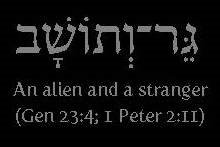Take a look at Abraham's family tree as it is reconstructed from Gen 11:20-32 and 20:12:
 Along with a lot of other new names, Jubilees (11:15) tells us that Terah and Edna named their son Abram after Edna's father Abram, who, it so happens, was married to Terah's aunt. Sound confusing? Look at the chart (names mentioned in Jubilees are in italics):
Along with a lot of other new names, Jubilees (11:15) tells us that Terah and Edna named their son Abram after Edna's father Abram, who, it so happens, was married to Terah's aunt. Sound confusing? Look at the chart (names mentioned in Jubilees are in italics): I'm a little surprised that Jubilees appears to list Sarai as Abra(ha)m's real sister, not his half-sister as Gen 20:12 would have it.
I'm a little surprised that Jubilees appears to list Sarai as Abra(ha)m's real sister, not his half-sister as Gen 20:12 would have it.The only real evidence that the Byzantine chronicler, Cedrenus, was familiar with this part of Jubilees is a reference to Terah's wife Edna and her father (our Abram's grandfather) Abram.
 In Cedrenus, however, it is not Edna's mother but her father who shows up as Nahor's brother.
In Cedrenus, however, it is not Edna's mother but her father who shows up as Nahor's brother.I would not have bothered to work out Abram's family tree if I were not working through references to Jubilees in Cedrenus for the Online Critical Pseudepigrapha (mentioned already here). When I first read this section of Cedrenus, I thought I saw the name of Abram's maternal great-grandfather, and I wanted to know where in the world Cedrenus got that information. In the end, all I needed to do was slow down and read Cedrenus more carefully. As he often does, Cedrenus was merely synchronizing the biblical story with extra-biblical events. In this case, he was coordinating the year of Abram's birth with the reign of Ninus, the first king of the Assyrians, and the 16th dynasty of Thebes. But the chart was interesting anyway.

2 comments:
I read Jubilees about 2 years ago. My wife is a Mathmatics Professor and over this coming semester break, she's going to venture into the mathmatics regarding the seasons/years in the writing. Does anyone else know anywhere to go for a resource on this aspect of the book?
Hi xwingrepair4cheap,
Thanks for your comment!
A great place to start is James C. VanderKam, "Studies in the Chronology of Jubilees," pages 522-544 in From Revelation to Canon (ed. James C. VanderKam; Leiden: Brill, 1999). For a solid introduction to Jubilees you might also try The Book of Jubilees (Sheffield: Sheffield Academic, 2001), by the same author.
I understand there is some evidence that the 364 day calendar used in Jubilees and 1 Enoch 72-82 relies on a mathematical system with origins in Mesopotamia. Sounds like an interesting study!
Post a Comment